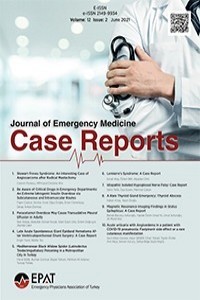Dinitro-Ortho-Cresol Maruziyeti Sonrasında Akut Koroner Sendrom Gelişen Ardışık İki Hasta
2, 4-Dinitrofenol, akut koroner sendrom, 2, 4-Dinitrofenol toksik maruziyeti, DNOC
Two Consecutive Acute Coronary Syndrome Patients after Dinitro-Ortho-Cresol Exposure
2, 4-dinitrophenol, acute coronary syndrome, toxic exposure to 2, 4-dinitrophenol, DNOC,
___
- Dere E, Ozdikicioglu F, Tosunoglu H. Hepatotoxicity of Dinitro-O-Cresol in Rats (Rattus norvegicus), Acta Vet (Beograd) 2007; 57: 497-507. [CrossRef]
- Lu YQ, Jiang JK, Huang WD. Clinical features and treatment in patients with acute 2,4-dinitrophenol poisoning. J Zhejian Univ-Sci B 2011; 12: 189-92. [CrossRef]
- National Research Council. Drinking Water and Health. Vol. 4. Washing- ton. National Academy Press; 1982.p.203.
- Bains France. World Health Organization/International Programme on Chemical Safety; Environmental Health Criteria 220 Dinitro-ortho-cresol. 2000.p.1-4.
- Harvey DG, Bidstrup PL, Bonnell JA. Poisoning by dinitro-ortho-cresol; some observations on the effects of dinitro-ortho-cresol administered by mouth to human volunteers. Br Med J 1951; 2: 13-6. [CrossRef]
- Ray S, Peters CA. Changes in microbiological metabolism under chemi- cal stress. Chemosphere 2008; 71: 474-83. [CrossRef]
- Bartlett J, Brunner M, Gough K. Deliberate poisoning with dinitrophenol (DNP): an unlicensed weight loss pill. Emerg Med J 2010; 27: 159-60. [CrossRef]
- Tewari A, Ali T, O’Donnell J, Butt MS. Weight loss and 2,4-dinitrophenol poisoning. Br J Anaesth 2009; 102: 566-7. [CrossRef]
- Brown, Michael A, Robert L. Chessin. Toxicological profile for dinitrocre- sols. Research Triangle Inst., Durham, NC (United States), 1995.p.31.
- Gosselin Robert E., Roger P. Smith, and Harold C. Hodge. Clinical toxi- cology of commercial products. 5th ed. Baltimore Williams & Wilkins, 1984..p.157.
- Yayın Aralığı: 4
- Başlangıç: 2010
- Yayıncı: Alpay Azap
Sadece Başım Ağrıyor... İzole Transvers Sinüs Ven Trombozu
Ayhan ÖZHASENEKLER, Hasan Mansur DURGUN, Ömer KAÇMAZ, İbrahim TUNÇ, Eşref AKIL, Hakan ÖNDER
Nurşah BAŞOL, Ufuk TAŞ, Murat AYAN, Mehmet ESEN, Muhammet ARSLAN, İlyas KOÇ, Berat ACU
Yabancı Cisime Bağlı Gelişen Brakiyal A-V Fistül: Olgu Sunumu
Mehmet KOŞARGELİR, Mehmet Özgür ERDOĞAN, İsmail TAYFUR, Şahin ÇOLAK, Burcu Genç YAVUZ
Amatör Futbol Oyuncusunda Anterior İnferior İliak Spine Avulsiyon Kırığı
Alper ÇIRAKLI, Eyüp Çağatay ZENGİN, Hicabi SEZGİN, Sevgi ÇIRAKLI, Murat ERDOĞAN
Spinal Anestezi Sonrası Gelişen Bilateral İntrakranial Subdural Hematom: Olgu Sunumu
Abdülkadir İSKENDER, Ömer AYKANAT, Hayati KANDİŞ
An Unusual Cause of Penetrating Abdominal Trauma: Nail Gun
Bekir SARICIK, Zeynep ÖZKAN, Evrim GÜL, Seyfi EMİR, Fatih Mehmet YAZAR, Burak KAVLAKOĞLU
Tibia ve Fibula Kırığı Olan Hastadaki Gizli Lisfranc Çıkığı
Mustafa UZKESER, Sultan Tuna Akgöl GÜR, Mesut KILIÇ, Ayhan AKÖZ, Hüseyin ŞAHİN, Mücahit EMET, Fatih ALPER
Amantadin İnfüzyonu Sonrası Nörolojik İyileşme
Nalan Metin AKSU, Huleyde ŞENLİKÇİ, Meltem AKKAŞ, Mehmet Mahir ÖZMEN
Dinitro-Ortho-Cresol Maruziyeti Sonrasında Akut Koroner Sendrom Gelişen Ardışık İki Hasta
Ahmet Oğuz BAKTIR, Hayrettin SAĞLAM, Bahadır ŞARLI, Hüseyin ARINÇ, Yasemin DOĞAN, Hüseyin KATLANDUR
Atıf BAYRAMOĞLU, İhsan Saygın SARI, Ayhan AKÖZ, Serhat KARAMAN, Özlem BİLİR, Ümit KAMACI
